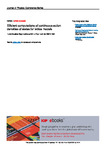Efficient computations of continuous action densities of states for lattice models
| dc.contributor.author | Lucini, B | en |
| dc.contributor.author | Francesconi, O | en |
| dc.contributor.author | Holzmann, M | en |
| dc.contributor.author | Lancaster, D | en |
| dc.contributor.author | Rago, A | en |
| dc.date.accessioned | 2022-04-25T11:41:51Z | |
| dc.date.available | 2022-04-25T11:41:51Z | |
| dc.date.issued | 2022-03-01 | en |
| dc.identifier.issn | 1742-6588 | en |
| dc.identifier.uri | http://hdl.handle.net/10026.1/19068 | |
| dc.description.abstract |
<jats:title>Abstract</jats:title> <jats:p>The Logarithmic Linear Relaxation (LLR) algorithm is an efficient method for computing densities of states for systems with a continuous spectrum. A key feature of this method is exponential error reduction, which allows us to evaluate the density of states of a system over hundreds of thousands of orders of magnitude with a fixed level of relative accuracy. As a consequence of exponential error reduction, the LLR method provides a robust alternative to traditional Monte Carlo calculations in cases in which states suppressed by the Boltzmann weight play nevertheless a relevant role, e.g., as transition regions between dominant configuration sets. After reviewing the algorithm, we will show an application in U(1) Lattice Gauge Theory that has enabled us to obtain the most accurate estimate of the critical coupling with modest computational resources, defeating exponential tunneling times between metastable vacua. As a further showcase, we will then present an application of the LLR method to the decorrelation of the topological charge in SU(3) Lattice Gauge Theory near the continuum limit. Finally, we will review in general applications of the LLR algorithm to systems affected by a strong sign problem and discuss the case of the Bose gas at finite chemical potential.</jats:p> | en |
| dc.format.extent | 012052 - 012052 | en |
| dc.language.iso | en | en |
| dc.publisher | IOP Publishing | en |
| dc.title | Efficient computations of continuous action densities of states for lattice models | en |
| dc.type | Journal Article | |
| plymouth.issue | 1 | en |
| plymouth.volume | 2207 | en |
| plymouth.publication-status | Published | en |
| plymouth.journal | Journal of Physics: Conference Series | en |
| dc.identifier.doi | 10.1088/1742-6596/2207/1/012052 | en |
| plymouth.organisational-group | /Plymouth | |
| plymouth.organisational-group | /Plymouth/Faculty of Science and Engineering | |
| plymouth.organisational-group | /Plymouth/Faculty of Science and Engineering/School of Engineering, Computing and Mathematics | |
| plymouth.organisational-group | /Plymouth/Users by role | |
| plymouth.organisational-group | /Plymouth/Users by role/Academics | |
| plymouth.organisational-group | /Plymouth/Users by role/Researchers in ResearchFish submission | |
| dc.identifier.eissn | 1742-6596 | en |
| dc.rights.embargoperiod | Not known | en |
| rioxxterms.versionofrecord | 10.1088/1742-6596/2207/1/012052 | en |
| rioxxterms.licenseref.uri | http://www.rioxx.net/licenses/all-rights-reserved | en |
| rioxxterms.type | Journal Article/Review | en |


